|
CONTENTS
OF THIS SECTION |
|
UNESCO World
Heritage Listing |
|
|
|
Professor
T.V.Mahalingam, University of Madras on Mahabalipuram in
Tamil Art & Architecture paper presented at Second International
Conference Seminar of Tamil Studies, January 1968 |
|
The
Shore Temple at Mamallapuram, Dr.R.Nagaswamy in
Art & Culture of Tamil Nadu, 1980 |
|
மாமல்லை -
டாக்டர். இரா. நாகசாமி
|
|
Dr.Justice
S.Maharajan on Tamil Culture at the 5th World Tamil Conference
in Chennai, 1981 |
|
South
India's Kingdom by the Sea - Katherine Tanko, 19 February 1999 |
|
National Institute of Oceanography: Mahabalipuram
and Poompuhar There exists a
popular belief in south India that the
Shore Temple of Mahabalipuram is the last of a series of
seven temples, six of which have been submerged. NIO team and
members of the Scientific Exploration Society, U.K., explored
Mahabalipuram. The archaeologists, professional divers and
photographers carried out underwater explorations during April
2002 and
recorded evidence of ruins off Mahabalipuram. " |
|
Under Water Investigations off Mahabalipuram Sundaresh*,
A. S. Gaur, Sila Tripati and K. H. VoraNational Institute of
Oceanography, Dona Paula, Goa, 10 May 2004 "Mahabalipuram,
the famous centre of Pallava art andarchitecture, is situated on
the coast of Tamil Nadu.The local traditions and the foreign
accounts vividlyrefer to the submergence of six temples out of
seventhat existed here. Recent underwater archaeological
explorations in the area have revealed many structural remains
including fallen walls, scattered dressedstone blocks, a few
steps leading to a platform and manyother structural remains.
The structures were badlydamaged and scattered owing to strong
underwater currents and swells. Due to thick biological
growth,engravings on the stone blocks, if any, could not
benoticed. Based on its alignment and form, they are con-sidered
to be of man-made in origin. Based on the archa-eological
evidences on land, the earliest possible dateof these structures
is estimated to be around 1500 years. The major cause of the
submergence of these struc-tures is severe coastal erosion
prevailing in the region." |
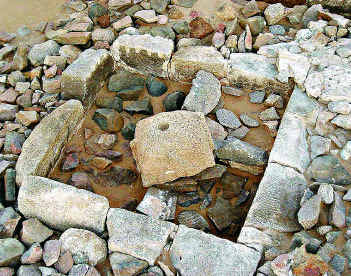 Newly-discovered
Mamallapuram temple fascinates archaeologists, April 2005
The temple discovered by the Archaeological Survey of India
(ASI), a few hundred metres to the south of the Shore Temple at
Mamallapuram, near Chennai, must have been as big or even bigger
than the Shore Temple, said archaeologists conducting the
excavation there. The ASI had discovered massive remains of a
temple on the shore, close to the Shore Temple during the
excavations it had conducted in February and March. Newly-discovered
Mamallapuram temple fascinates archaeologists, April 2005
The temple discovered by the Archaeological Survey of India
(ASI), a few hundred metres to the south of the Shore Temple at
Mamallapuram, near Chennai, must have been as big or even bigger
than the Shore Temple, said archaeologists conducting the
excavation there. The ASI had discovered massive remains of a
temple on the shore, close to the Shore Temple during the
excavations it had conducted in February and March.
While continuing the excavation, it discovered a subsidiary
shrine adjacent to the remains of a square garbha graham
(sanctum sanctorum) of the newly- discovered temple.
The garbha graha measures 2.6 metres by 2.6 metres. The sanctum
sanctorum is surrounded by an open courtyard, which is encircled
by a massive prakara (outer wall). A beautiful ring-well, made
of terracotta; a sculpted capstone, a shikara stone; parts of a
stupa; granite architectural members with sockets; and beautiful
potsherds have been found within this temple complex.
The newly discovered temple "is a separate complex by itself.
Its magnitude and area is akin to that of the Shore Temple,"
said T. Satyamurthy, Superintending Archaeologist, ASI, Chennai
Circle. Alok Tripathi, Deputy Superintending Archaeologist,
Underwater Archaeology Wing, ASI, who is heading the current
excavation at Mamallapuram, said, "This temple must have been as
big or bigger than the Shore Temple."
What has fascinated archaeologists is that mason's marks
(engravings) have been found on the granite architectural
members of the square garbha graha.
These mason's marks depict a bird, a lamp, a bow and arrow, and
two interconnected triangles. The bird occurs like a leitmotif
on several stones.
"We have found a lot of mason's marks, who built this temple. We
have to compare these mason's marks [with those found elsewhere]
and find out whether the same group built the temples at
Kancheepuram. In the temples in north India, the mason's marks
have been studied quite well," Dr. Tripathi said.
Mamallapuram is known for its unparalleled works of architecture
including open-air bas relief, rock cut temples and structural
temples built by the Pallava kings Mahendravarman,
Narasimhavarman I, Paramesvara and Narasimhavarman II, during
the 7th and 8th century A.D.
The majestic Shore Temple, which stands on the edge of the sea,
was built by Narsimhavarman II (circa 690- 715 A.D.). He also
built the huge Kailasanatha temple and the Iravatanesvara temple
at Kancheepuram. Nandivarman II (circa 736-769 A.D.) built the
Vaikunta Perumal temple.
Obviously, the newly discovered temple close to the Shore
Temple, was built by the Pallava kings. The question that arises
is: why did the Shore Temple survive while this one did not? |
|
Mahabalipuram |
|
Shore Temple, Mahabalipuram |
|
Seven Pagodas of Mahabalipuram |
|
|
DRAVIDIAN
TEMPLE ARCHITECTURE
Mahabalipuram
(Mamallapuram) Shore Temple
Pallava Period ( 7th - 9th century)
 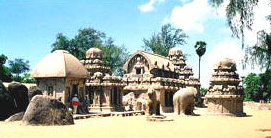
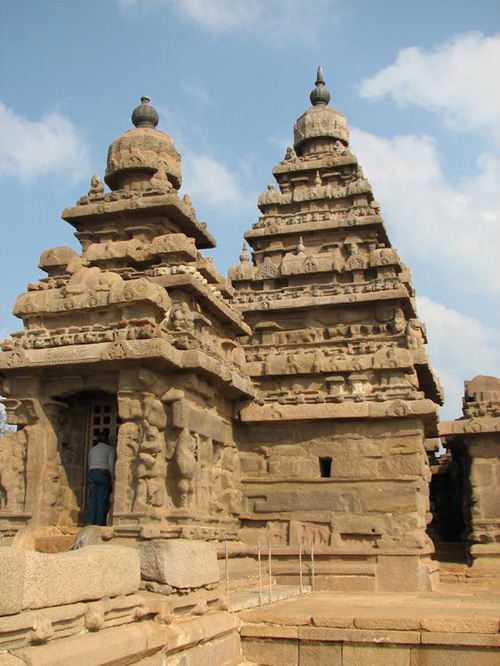 |
|
|
"In the field of art and architecture, the
Pallavas and Pandyas cut many cave temples and monolithic
'rathras'. It was followed by many structural temples of which
the Shore temple at Mahabalipuram and the
Kailasanatha
temple in Kanchi are the earliest." (Ancient Tamil
Country, Dr.S.Sundararajan - Navrang, New Delhi, 1991)
"The early
phase, (of medieval temple architecture: South Indian style of
Tamil Nadu (7th-18th century) which, broadly speaking, coincided
with the political supremacy of the Pallava dynasty (c.
650-893), is best represented by the important monuments at
Mahabalipuram." (Medieval temple architecture:
South Indian style of Tamil Nadu (7th-18th century
-Encyclopaedia Britannica)
|
|
 UNESCO World Heritage Listing,
15 October 1983
UNESCO World Heritage Listing,
15 October 1983
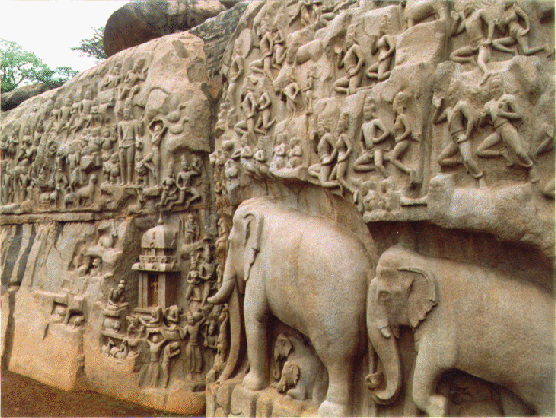
International Council on Monuments and Sites (ICOMOS)
Recommendation, May 1984 - That the proposed cultural property
be included on the World Heritage List based on the criteria I, II,
III and VI.
Justification
Founded in the 7th century by thePallavas sovereigns south of Madras, the
harbour of Mahabalipuram traded with the distant kingdoms of southeast Asia :
Kambuja (Cambodia), Shrivijaya (Malasia, Sumatra, Java) and with the empire of
Champa (Annam) . But the fame of its role as a harbour has been transferred to
its rock sanctuaries and Brahman temples which were constructed or decorated at
Mahabalipuram between 630 and 728. These monuments may be subdivided in four
categories :
- the ratha temples in the form of processional chariots, monolithic
constructions cut into the residual blocks of diorite which emerge from the
sand. The five rathaof the south, which are the most famous,date to the reign of
Naharasimhavarman Mamalla (630-668), the great Pallavas king (the Cholas texts,
moreover, call the city Mamallapuram) .
- the mandapa , or rock sanctuaries Modeled as rooms
covered with bas-reliefs (the mandapa of
Varaha, representing the acts of this avatar of Vishnu; the
mandapa of the five Pandavas and, especially, the mandapa of Krishna
and the mandapa of Mahishasuramardini).
- the rock reliefs in open air, the largest of which is world
renowned, illustrates a popular episode in the iconography of Siva, that of the
Descent of the Ganges : the wise King Baghirata having begged him to do so, Siva
ordered the Ganges to descend to earth and to nourish the world. The sculptors
used the natural fissure which divided the cliff to forcefully suggest this
cosmic event to which a swarming crowd of gods, godesses, mythical beings
(Kinnara, Gandherva, Apsara, Gana, Naga and Nagini), savage and domestic animals
bear witness.
- temples, constructed in cut stone, like the temple of Rivage, which
was constructed under the King Rajasimha Narasimhavarman II (695-722), with its
high stepped pyramidal tower and thousands of sculptures dedicated to the glory
of Siva.
ICCMOS recomends the inclusion of the monumental ensemble of
Mahabalipuram on the World Heritage List based on criteria I, II,
III and VI.
- criterion I : the bas-relief of the "Descent
of the Ganges" is -like that of the island of Elephanta a uniaue artistic
achievement.
- criterion II : the influence of the sculptures of Mahabalipuram,
characterized by the softness and suppleness of their modeling, spread afar
(Cambodia, Annam, Java).
- criterion III : Mahabalipuram is, preeminently, the testimony to the
Pallavas civilization of southeast India,
- criterion VI : the sanctuary is one of the major centres of the cult of
Siva.
|
 Professor T.V.Mahalingam, University of Madras on
Mahabalipuram in
Tamil
Art & Architecture paper presented at
Second International Conference Seminar of Tamil Studies,
January 1968
Professor T.V.Mahalingam, University of Madras on
Mahabalipuram in
Tamil
Art & Architecture paper presented at
Second International Conference Seminar of Tamil Studies,
January 1968
"Under Narasimhavarma I, Pallava rock-architecture took a
new turn. besides cutting into rocks for caves, attempts
were made to cut out monoliths from rocks. The rudiments of
this practice are to be found in the carved-out stupas in
the caves of Western India and the vimana-form in the Tawa
cave at Udayagiri but it was at Mahabalipuram under the
Pallavas that it found a full and eloquent expression.
Architecturally they depict the external aspects of
contemporary brick and timber structures. There are as many
as nine monoliths at Mahabalipuram of which the five, named
after the Pandavas and Draupadi, are a well-known assemblage
of contiguous excavations, the other examples are the Ganesa
ratha, Valayankuttai ratha and the two Pidari rathas. As
they represent varying architectural designs they are of
primary importance for any study of the plan and different
zones and the details of the Yima-nas.
The
Dharmaraja-ratha is three-storeyed with a square viguana
and an octagonal dome. Though the
Arjunaratha is similar to this it is two-storeyed. The
Bhimaratha has a wagon-top roof and is single-storeyed
unlike the Ganesa ratha, another example of wagon top roof,
which is double-storeyed. The
Draupadiratha
is hut-shaped and is square in plan and its roof is domical.
The
Sahadevaratha represents the apsidal form with its back
resembling that of an elephant, a feature high-lighted by
the carving of a huge elephant by the side of the
monolith. "
|
|
 The Shore Temple at Mamallapuram - R.Nagaswami in Art &
Culture of Tamil Nadu, 1980
The Shore Temple at Mamallapuram - R.Nagaswami in Art &
Culture of Tamil Nadu, 1980
 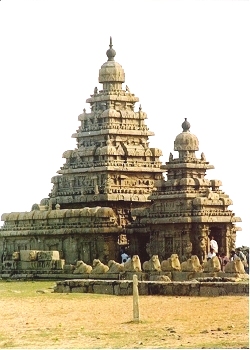 |
|
"Mamallapuram was developed as flourishing seaport by the great
Pallava monarch, Narasimhavaraman I, and has ever since remained
important in the history of south India. A naval fleet was
despatched from here, by the same king, to Sri Lanka which was
conquered and his vassal, Manavarman, installed on the throne. But
above all, the grand conception of Rajasimha in cutting huge
boulders of granite into exquisitely carved rathas has provided this
seaside village with the most attractive and important monuments in
India. The free standing monolithic temples called rathas, the
lavishly sculptured cave-temples and the huge rock-face portraying
the sculptures narrating the story or Arjuna obtaining the pasupata
situated almost on the seashore, draw the admiration of the world.
The charm of the place is enhanced by a temple with two towers,
familiarly known as the Shore Temple.
Set against the background of unfathomable sky and the boundless
sea, each merging with the other in a far off horizon, with the
melody of the waves gently rolling over the outer walls, with the
two towers as if piercing the blue canopy of the sky, with their
sharp spires and with the green wood in the front welcoming the
visitor with a gentle breeze, the Shore Temple has a splendour
unsurpassed in aesthetic appeal. With the rising sun spreading its
rays like a golden ball, with white clouds moving across, the towers
are most fascinating. The temple, standing as it is on the coast for
over a thousand years with most of its sculptures having been
eroded, due to saline action but leaving vestiges here and there,
mere outlines, shines in its pristine glory.
This temple is the most complex group of all the temples of south
India, having two shrines placed one behind the other, one facing
east and the other west. These two shrines are separated by a
rectangular shrine sandwiched in between and having its entrance
from the side. This shrine is dedicated to Vishnu, who is
represented as lying on his serpent couch and known as Talasayana
Perumal. The other two shrines are dedicated to Siva. There is a
large open court at the western end.
A little to the south of the sancta and within the compound is a
majestic lion which carries a miniature Mahishasuramardini carved
inside a square cavity cut in the neck of the animal. Two attendant
deities of the Goddess are shown as mounted on either side of the
animal. A little to north of this, in the platform, is an
exquisitely carved deer shown with majestic ease. Unfortunately its
head is mutilated. In between the deer and the lion could be noticed
a dwarf with only the legs preserved.
This temple with triple shrines was built by Narasimhavarman II,
familiarly known as Rajasimha. That Rajasimha was a great patron of
art, literature and other fine arts is revealed in innumerable
titles he assumed for himself like Vinanarada. He was a great
devotee of Siva and a prolific temple-builder. Both lithic records
and copper plate grants of the Pallavas extol him as one who
lavished wealth on temples and scholars.
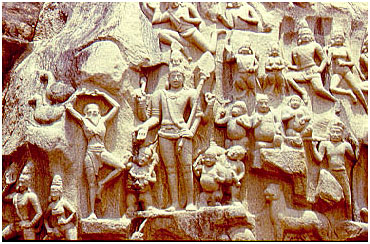
It is to the genius of this monarch that we owe the monumental
Kailasanatha temple of
Kanchipuram, and the Talagirisvara temple at Panamalai. An
inscription in Pallava grantha characters, in the balipitha at the
western end of the Shore Temple, extols the prowess of Rajasimha.
This temple has been so often visited and illustrated that the
very name of the Shore Temple would recall the two towers standing
on the shore. However, there is one factor which has escaped
attention. The temple originally consisted of three, vimanas the
third vimana which was over the Vishnu shrine has crumbled down.
That these shrines were under regular worship for long is borne out
by literature and epigraphs.
Thirumangai Alvar, who lived in the eighth century A.D. has sung
of the temple and refers to Lord Vishnu as Kadalmallai Talasayana.
Rajaraja, the great Chola emperor, has left two inscriptions in the
temple, recording gifts of lands, etc. Interestingly he mentions the
names of the three shrines of at Kshatriyasimha Pallavesvaragriham,
Rajasimha Pallavesvaragriham and Pallikondaruliya Devar shrine.
As mentioned above, Rajasimha who constructed this temple, was a
king of varied tastes and delighted in assuming hundreds of titles,
as evidenced from the Kailasanatha temple inscriptions. Amongst his
titles, mention may be made of Rajasimha, Narasimha, Kshtriyasimha
and Purushasimha, as also Mahamalla, Saturmalla, Amitramalla, etc.
It is, therefore, evident that the Kshatriyasimha Pallavesvara
and Rajasimhapallavesvara mentioned in the inscription are after
Rajasimha's titles. A recently discovered label inscription found on
the lintel of this Vishnu shrine, in the Pallava grantha script of
the Rajasimha age, gives the name of the temple as Narapathisimha
Pallava Vishnu griham. This find confirms that the Vishnu temple was
also built by Rajasimha. The other reference is to the Talasayana
shrine. An inscription of Virarajendra Chola, also found in the
temple, refers to this Lord as Kadalmallai Emperuman.
From the above it is evident that all the three shrines in the
temple were under regular worship for a considerable time. It is
well-known, that according to the prevalent custom, a temple is
placed under worship only when it is crowned with a vimana, and duly
consecrated with a stupi (Kzcmbhabisheka). It is, therefore, certain
that the Talasayana shrine of the temple had a vimana, which has
crumbled.
The above conclusion is amply justified by the presence of a
course of rectangular and square pavlion ornaments (bhadrasalas and
vimana types) which formed the first storey of the vimana. This is
further proved by the rectangular pavilion ornaments of the other
storyes still lying scattered inside the compound. Judging from the
extant remains, the vimana was of a rectangular type with a series
of stupis arranged in a line on it ridges, and attained a height
between those of the big and the small towers.

Varaha
Though rectangular vimana over the sanctum went out of existence
in later times, it was present Pallava days. The monolithic temples
of Ganesa and Bhima rathas, both in Mamallapuram, are splendid
examples of the rectangular vimanas. The Mahendravarmesvaragriha,
constructed at the entrance of the Kailasanatha temple of
Kanchipuram by Rajasimha's son, a structural example of the
rectangular vimana still preserved.
The same rectangular structures form the principal form of the
gateway towers called gopuras in the south Indian temple-complex in
the succeeding centuries. Rajasimha's conception of this
temple-complex, with two square vimanas interspersed with a
rectangular one, each spire from the land's side showing an increase
in height and the whole being set against the background of the
ocean is indeed a marvel, an inspiration and vision quite befitting
a great artist like Rajasimha."
|
|
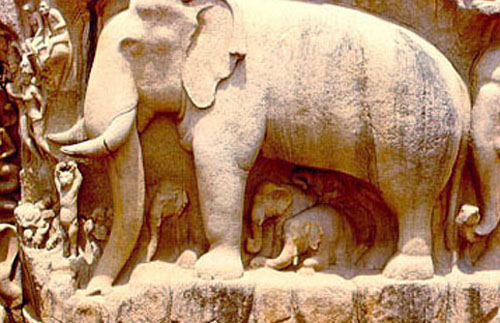
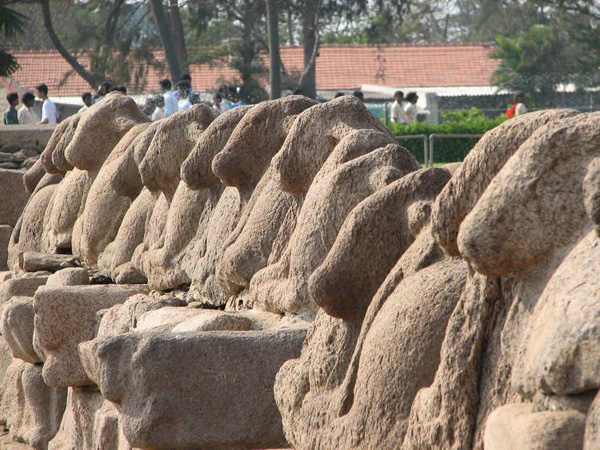
|
|
 Dr.R.Nagasamy in Mahabalipuram on the Web [see also
Listing of Other Books by Dr.R.Nagasamy]
Dr.R.Nagasamy in Mahabalipuram on the Web [see also
Listing of Other Books by Dr.R.Nagasamy]

மூவிலை
நெடுவேல் ஆதி வானவன்
இடமருங்கு ஒளிக்கும் இமையக் கிழவி
தனிக்கண் விளங்கு நுதற்பிறை மேலோர்
மிகப்பிறை கதுப்பிற்
சூடி வளைக்கையின்
வாள்பிடித்து ஆளியேறித் தானவன்
மாளக் கடும்போர் கடந்த குமரி
மூவா மெல்லடித் திருநிழல்
வாழி காக்கவிம் மலர்தலை யுலகே
ஆசிரிய மாலை
 Preface by Era
Neduncheliyan - தமிழக அரசு கல்வி
அமைச்சர் மாண்புமிகு நாவலர் இரா நெடுஞ்செழியன் அவர்களின்
அணிந்துரை
Preface by Era
Neduncheliyan - தமிழக அரசு கல்வி
அமைச்சர் மாண்புமிகு நாவலர் இரா நெடுஞ்செழியன் அவர்களின்
அணிந்துரை
தமிழக வரலாற்றுப் புகழையும், பண்பாட்டுப்
பெருமையையு, நாகரிக மேம்பாட்டையும் விளக்கிக் காட்டிடும்
அரண்மனைகள், கோட்டைகள், கோயில்கள், கட்டிடங்கள், குகைகள்,
சிற்ப்பங்கள், கல்வெட்டுகள், செப்பேடுகள், ஓலைச்சுவடிகள்,
மண்டையோடுகள், புதைபொருட்கள் தமிழக் மெங்கணும் சிதறிக்
கிடக்கின்றன.
அவற்றையெல்லாம்
பேசவைக்கும் பணியில் தொல்பொருள் ஆராய்ச்சியாளர்கள், வரலாற்றுப்
பேராசிரியர்கள், இலக்கிய வல்லுநர்கள், கலைஞர்கள் ஆகியோர்
சென்ற் சில காலமாக ஈடுபட்டு வருகின்றனர்.
மேலை நாடுகளில் வரலாறு,
இலக்கியம், கல்வெட்டுகள், கலை ஆகியவற்றின் அடிப்படையில் எண்ணற்ற
வியப்புக்குரிய நூல்கள் அந்தந்த நாட்டின் சிறப்பை வெளிப்படுத்தும்
முறையில் வெளிப்பட்டு வருகின்றன. வரலாற்றுப் பெருமை வாய்ந்த கலைச்
செல்வங்களைக் காணச் செல்வதற்கு முன்னர் அவை பற்றிய் நூல்களைப்
படித்துப் பார்த்து விட்டு தூண்டப்பட்ட ஆவலுடன் அச்செல்வங்களைக் காண
விழைகின்றனர்.
குறிப்பாக மேலை நாடுகளில்
கல்லூரி மாணவர்களிடத்திலும் பள்ளி மாணவர்களிடத்திலும் இந்தப் பழக்கம்
பரவலாகக் காணப்படுகின்றது. இது போன்ற பழக்கம் நம் நாட்டிலும்
பெருகினால்தான் நம் கலைச் செல்வங்களின் அருமை பெருமைகளை நாமும் உணர
முடியும்; பிறர்க்கும் உணர்த்த முடியும். தமிழகத்திலும் அப்படிப்பட்ட
நூல்கள் உருவாக்கப்பட வேண்டும் என்பது தான் தமிழக அரசின் பேராவலாகும்.
அந்த ஆவலை நிறைவேற்ற எடுத்தௌக் கொண்ட ஒரு முயற்சியின் விளைவுதான்
"மாமல்லை" என்னும் இந்நூல்.
இந்நூல் வரலாற்றுச்
சிறப்புப் பெற்ற, சிற்பக் கலை நிரம்பிய மாமல்லபுரத்தைப் பற்றிய பல்வேறு
செய்திகளை நிரம்பிய மாமல்லபுரத்தைப் பற்றிய பல்வேறு செய்திகளை
இலக்கியத்திலிருந்தும், கல்வெட்டுக்களிலிருந்தும், சிற்பக்கலை
நுணுக்கத்திலிருந்தும், வரலற்றுக் குறிப்புக்களிலிருந்தும் திரட்டித்
தருகிறது.
தமிழ்க அரசின் தொல்பொருள்
ஆரய்ச்சித்துறையின் இயக்குநரும், சிறந்த்த இலக்கிய நுண்ணறிவு,
கல்வெட்டு ஆராய்ச்சியறிவு, தொல்பொருள் ஆராய்ச்சியரறிவு, வரலாற்றறிவு,
ஆகியவற்றை ஒருங்கே பெற்றவரும் ஆன திரு இரா. நாகசாமி அவர்கள் இந்நூலை
உருவாக்கித் தந்திருப்பது பாராட்டுவதற்குரியதாகும்.
ஆசிரியர் இனிய, எளிய
தமிழிலும், இலக்கிய நயம் சிறக்க அழகான முறையில் எழுதியுள்ளார்.
தமிழக அரசின் தொல்பொருள்
ஆய்வுத்துறை வரலாற்று அடிப்படையில் கொண்டு வந்துள்ள முதல் நூல்
"மாமல்லை" என்ற இந்த ஆராய்ச்சி நூலாகும். இது போன்ற பல நூல்கள் வெளிவர
வேண்டும் என்பது தமிழக அரசின் பேராவலாகும்.
தமிழ்க பெருமக்கள்
இந்நூலுக்குப் பேராதரவு தந்து அதனால் பெரும் பயன் பெறுவார்களாக.
|
|
 தமிழக அரசு
பொதுப்பணித்துறை அமைச்சர்
தமிழக அரசு
பொதுப்பணித்துறை அமைச்சர்
மாண்புமிகு கலைஞர் மு. கருணாநிதி அவர்களின்
அணிந்துரை
தமிழக அரசின் தொல்பொருள் ஆய்வுத்துறையின் முதல் வெளியீடாக
"மாமல்லை" வெளிவருகிறது. தமிழகத்தில் புத்தாட்சி
மலர்ந்ததிலிருந்து தமிழ் வளரவும், தமிழ்க் கலையும், பண்பாடும்
செழிக்கவும் அரசு நாள் தோறும் நல்ல பணிகளை மேற்கொண்டு வருவது
பெருமக்கள் யாவரும் அறிந்ததே. நமது மரபின் மாபெரும் சிறப்புப்
பற்றித் தெளிவாகத் தெரிந்து கொள்வது நமது வாழ்வின்
மறுமலர்ச்சிக்கு மிக இன்றியமையாததாகும்.
கல்லும் கதை சொல்லும் கடல்மல்லையின் வரலாற்றை ஊடுருவிப்
பார்த்து அரிய பல உண்மைகளை அழகிய முறையிலும், நெஞ்சத்தில்
பதியக்கூடிய வகையிலும் சொல்கிறது இந்நூல். தொல்பொருள்
ஆய்வுத்துறையிலும், இலக்கிய, வரலாற்றுத் துறைகளிலும் ஆழ்ந்த
அனுபவம் உள்ள திரு இரா. நாகசாமி இந்நூலை எழுதியிருக்கிறார்.
நடை எளிமையாகவும், சரளமாகவும் இருக்கிறது. வரலாற்றுச் சிறப்பு
மிக்க சின்னங்களை பற்றிய நூல்களை, இலக்கிய அடிப்படையிலும்,
வரலாற்று அடிப்படையிலும் இயற்றி, மக்களுக்குக் குறைந்த
விலையில் வழங்க வேண்டும் என்ற அரசின் திட்டப் படி "மாமல்லை"
முதல் வெளியீடாக வெளி வருவது மக்களுக்கு மகிழ்ச்சி அளிக்கும்
என நம்புகிறேன். அனைவரும் இந்நூலை வரலாற்று ஆதரவு
நல்குவார்களாக!
மு. கருணாநிதி
|
|
 தமிழ்நாடு தொல்பொருள்
ஆய்வு ஆலோசனைக் குழு உறுப்பினர்
தமிழ்நாடு தொல்பொருள்
ஆய்வு ஆலோசனைக் குழு உறுப்பினர்
திரு. சா. கணேசன், M.L.C அவர்களின் முன்னுரை
பண்டையக் காலத்தில் மல்லை, மாமல்லை, கடல்மல்லை என்ற பெயர்களால்
விளங்கி, இடைக்காலத்தில் மகாபல்லபுரம், மல்லபுரி, ஜனநாதபுரம்
போன்ற பெயர்களைக் கொண்டிருந்து, பிற்காலத்தில் மகாபலிபுரம்
என்ற பெயராலே பெரும் புகழ்சூடி, இன்று மாமல்லபுரம் என
வழங்கிவரும் குன்றுகள் நிறைந்த இச்சிற்றூர் ஒரு சிற்பக்
கலைக்கூடமாகத் திகழ்வதை உலகம் நன்கறியும்.
ஒரு காலத்தில் வளம் சிறந்த துறைமுகப் பட்டினமாக விளங்கிய
பெருநகரம் காலவேந்தன் விளையாட்டால் வெயிலிடை விளக்காகி
விட்டது. மக்கள் எண்ணிக்கையும், வாணிகமும் குறைந்து ஊர்வளம்
சிறுத்தாலும் ஒப்பற்ற சிற்பங்கள் நிறைந்த கலைவளம் சுரப்பதில்
ஈடும் எடுப்புமின்றிப் பொலிகிறது. கலைச்சுவை தேர்வார் எல்லாம்
ஆயிரம் பல்லாயிரம் மைல்கட்கு அப்பாலிருந்தும் வந்து கண்டு
வியந்து களிப்பில் மூழ்கித் திளைக்கின்றனர். எனவே இவ்வூர்
தமிழர் கலைக்கும், நாகரிகத்திற்கும், பண்பாட்டிற்கும் இணையற்ற
சான்றுகளுடைய எடுத்துக் காட்டாய் விளங்குகிறது.
கட்டடம்,
சிற்பம், கல்வெட்டுகள் முத�லானவற்றின் வாயிலாகத் தமிழர்
வரலாற்றுத் துறை எத்தனை எத்தனையோ சான்றுச் செய்திகளை மறுக்க
வொண்ணா முறையில் தந்து கொண்டிருக்கும் இவ்வூரைப் பற்றி அறிஞர்
பலர் ஆராய்ச்சிக் கட்டுரைகள் பலவற்றை எழுதி
உபகரித்துள்ளார்கள். சிறிய, பெரிய கட்டுரைகள் பல நூல்களாகவும்
வந்திருக்கின்றன. ஆனால் அவற்றில் மிகப்பல ஆங்கிலத்திலேயே
வந்தவை. ஆனால் அவற்றில் நிறை பெற்றவை எனக் கூற
முடியாவிட்டாலும் அவற்றின் அருமையை-பயனைக் குறைத்து
மதிப்பிடவும் கூடாது. அவ்வப் பொழுது அவரவர்கட்குக் கிடைத்த
வாய்ப்பையும், வசதியையும் கொண்டு சிறந்த முறையில்
பணியாற்றியுள்ள அவர்கட்கெல்லாம் எவ்வளவோ நன்றி பாரட்ட
வேண்டும்.
இத்துறையில் பணியாற்றிய பெரியவர்களுள் பழுத்த பழமாக வாழும்
திரு. கே. வி. சுப்பிரமணிஐயர் அவர்கள், அவரை தரிசிக்க சென்ற
என்னிடம், மாமல்லையை பற்றி மிக்க ஆர்வத்துடன் பேசினார்கள்.
"நீங்கள் உடனே
மாமல்லைக்குச் செல்லுங்கள். அதை சுற்றிய் பகுதிகளிலும்
அகழ்வாராய்ச்சி நடத்துங்கள். எத்தனையோ அரிய பெரிய
செய்திகளையும் சான்றுகளையும் நீங்கள் பெறலாம். தமிழகத்தின்
வரலாற்று நெறியாலே புகழ் தரக்கூடிய பலபல உண்மைகள் அங்கே
புதையுண்டு கிடக்கின்றன. அவற்றையெல்லாம் அகழ்ந்தெடுத்துப் புற
உலகுக்குப் புலப்படுத்துங்கள்" என்று துள்ளிக் குதிக்கும்
ஆர்வதுடனும், முதுமையில் சுரந்த இளமைத் துடிப்புடனும்
கூறினார்கள். பல்லாண்டு காலம் ஆற்றிய பணிகளின் பயனய் அடைந்த
அனுபவம், தம்மால் மேற்கொள்ள இயலாத நிலையில் யாராவது ஆற்றிப்
பயன் விளைவிக்க மாட்டார்களா என்னும் ஆர்வதுடன் கூடிய
அறிவுள்ளம் இப்படி சொற்களாக வெளிப்பட்டன.
இவற்றை எல்லாம்
மனத்துட்கொண்டு பார்க்கும் போது முன்னையோர் கொண்ட முயற்சிகளைப்
போற்றி அவர்கள் காட்டிய வழிகளில் முன்னேறிச் சென்று
காண்பனவற்றை ஆய்ந்தும், மறைந்து கிடப்பவற்றை அகழ்ந்து
ஆய்ந்தும் நம் வரலாற்றை, பண்டைப் பெருமைகளை வெளிப்படுத்த
வேண்டும். அப்படிப்பட்ட ஒரு பணி மிக மிக இன்றியமையத ஒன்று.
பழமை என்பது அரிய ஒரு செல்வம். ஒரு கட்டடதிற்கு அடிப்படையின்
ஆழம் எவ்வளவு வலிவை தருமோ அப்படியே அமைந்த பழமையின் முதுமை
வலிவையும், பொலிவையும் தருவதாகும். அதுவே பெருமையுமாகும்.
அங்கனம் முயன்று
உண்மை காணும் பொழுது முன்னையோர் முடிவுகளில் மாற்றம்
விளையுமானால் அது அவர்கட்கு இழைக்கும் அநீதி எனக் கூறப்படாது;
கூறவும் முடியாது. மாறாக அவர்கள் பணிக்கு விளக்கம் செய்வதால்
அவர்களை நன்றியுடன் போற்றியதாகவே அமையும். இந்த ஒழுங்கை
மறப்போமானால் ஆராய்ச்சி முடமாகி விடும்; ஆராய்ச்சித்
துறைக்கும், ஆராய்ச்சியாளர்கட்கும் "முடிந்தமுடிவு" என்பது
கொடிய பகையாகும்; வளர்ச்சிக்குப் பெரியதொரு முட்டுக்
கட்டையாகும்; இல்லையா?
இனி இந்நூலப்
பார்க்கலாம். இதன் ஆசிரியர் திரு. இரா. நாகசாமி தமிழகத்
தொல்பொருள் ஆய்வுத் துறையின் இயக்குநர். வரலாற்றுத் துறையை
நெறிப்படப் பயின்றவர், பல ஆண்டுகளாக மாமல்லையைச் சிந்தையிற்
கொண்டு, பல சான்றுகளையும் நேரில் கண்டு ஆய்ந்து வருப்வர்.
விருப்பு-வெறுப்புகளுக்கு இடம் தராது நடுநிலை நின்று உண்மை காண
முயல்பவர். எனவே இந்நூல் வளமாக உருப்பெற்றுள்ளதில்
வியப்பொன்றுமில்லை.
இந்நகரம் சங்க காலத்திற்குப் பிந்தாத காலத்திலிருந்தே சிறந்த
துறைமுக நகரமாக விளங்கியிருந்த்த தென்பது தெளிவு 'மாமல்லன்'
(மஹாமல்லன்) என்ற சிறப்பு பெயர் பூண்ட முதலாம் நரசிம்மவர்மன்
நினைவாகவே மாமல்லை அல்லது மாமல்லபுரம் என்று பெயர் என்பது
பொருந்தாது, அவனுக்கு முந்திய காலத்தவர் என ஒப்புக் கொள்ள
பெற்ற பூதத்தாழ்வார் 'மாமல்லை' எனக் கூறுவது இங்கு
கருதத்தக்கது.
சோழர் காலத்தில்,
நாகர் காலத்தில், பல்லவர் காலத்தில் காஞ்சி அரசின் தலைநகரமாக
இருந்தது. அபொழுதுதெல்லாம் மாமல்லையே துறைமுக நகரமாக
இருந்திருக்க வேண்டும். மல்லை, மல்லையர் கோன் என்ற சொற்களை
மனதிற் கொண்டு சிந்திப்போமானால் 'மாமல்லை' காரணமாகவே மாமல்லன்
என்ற சிறப்புப் பெயர் ஏற்பட்டிருக்கலாம் என்று துணிவது
பொருத்தமாக இருக்கும்.
தொண்டைமான்
இளந்திரையனைக் கடலூர் உருத்திரங் கண்ணனார் பாடிய
பெரும்பாணாற்றுப் படையில்,
"முந்த வார் மணல் பொற்கழங்கு ஆடும்
பட்டினம் ........................
என்று கூறுவது நோக்க ஒருகால் இந்நகரம் 'பட்டினம்' என்றே
சங்ககாலத்தில் வழங்கப்பட்டிருக்கலாம் என்பது சரியாகுமா?
இச்சந்தர்ப்பத்தில் "பட்டினப்பாலை" என்ற பெயரையும் அங்கும்
பூம்புகாரைப் 'பட்டினம்' (218) என்று பெயர்கூறுவதையும் நாம்
மறந்துவிட முடியாது; மறக்கவும் கூடாது.
இந்நகரின்
தொன்மைக்கு, பெரும்பாணாற்றுப் படையுடன், கி.பி. முதல்
நூற்றாண்டை ஒட்டி 'தாலமி' என்பவர் எழுதிய குறிப்பும்,
மாமல்லையில் கிடைத்த கி.பி. 4-ஆம் நூற்றாண்டைச் செர்ந்த யவனக்
காசும், சான்று பகர்வனவாம். இவற்றை எல்லாம் மனத்துட் கொண்டு
நேரிய நெறியில் சிந்திப்போமானால் இந்நகரத்தின் பழ்மையை
எக்காரணத்தாலும் சங்க காலத்திற்குப் பிந்தியதாகக் கொள்ளவோ,
கூறவோ முடியாது.
மேலும் அந்த
வட்டாரத்தில் அகழ்வாராய்ச்சி நடத்தினால் மேலும் பலபல சான்றுகள்
கிட்டும். அவற்றின் காரணமாய் நிச்சயம் மாமல்லையின் காலம்
மேலும் பின்னுக்குச் செல்லும் என்பதில் எனக்கு உறுதியான
நம்பிக்கை இருக்கிறது.
இந்த நூலை எழுதிய
ஆசிரியர் எடுத்துக் கொண்டுள்ள அக்கறையையும், வகுத்துக்
கொண்டுள்ள முறையையும் மன மாரப் பாரட்டுகிறேன்.
வாதப்பிரதிவாதங்களை மறைக்காமல் எடுத்துக் காட்டி மிக்க
பண்படோடு ஏற்றும், மறுத்தும் எழுதிச் செல்வது சிறப்பூட்டும்
ஒன்று.
முதல்
நரசிம்மனாகிய மாமல்லனா? அல்லது அவன் பேரன் முதல்
பரமேச்வரவர்மனா? அல்லது கொள்ளுப் பேரனான இராஜசிம்மன்,
அத்யந்தகாமன் என்ற பெயர்களுக்குரிய இரண்டாம் நரசிம்மவர்மனா?
யார் இங்குள்ள சிற்பப் பணிகளை எல்லாம் முற்றுவித்தார்கள்? பல
வேறு கருத்துகளையும் ஆய்ந்து இவ் வினாவிற்கு நூலாசிரியர் (49
முதல் 63) தரும் விடை சிந்திக்க தக்கது; எளிதாக மறுத்துவிட
முடியாது. கல்வெட்டுகள் முழுவதும் கண்டு, படித்து பொருள்
காணுமுன் கொண்ட கருத்துக்கள் மாறி மெய்ந்நிலை வெளிப்படல்
வரலாற்று நெறிக்கு வளமூட்டுவதாகும்.
இங்ஙனம் இந்நூல்
ஒரு சிறந்த படைப்பாகத் திகழ்கிறது. காண்போர்க்கும் ,
கற்போர்க்கும், ஆய்வோர்க்கும், அருந்துணை ஏடாக இது மடல்
விரித்திருக்கிறது. இதை மனமார வரவேற்கும் தமிழகம். இத்தகைய
நூல்கள் இன்னும் பலப் பல வெளிவர வேண்டும் ஆண்டவன் அருளும்,
அரசின் உதவியும் அறிஞர் உழைப்பும், அன்பர் ஆர்வமும் இதை
நிறைவேற்றித் தருவதாக்!
வாழ்க தொல்பொருள் ஆய்வுத்துறை! வளர்க அதன் பல்துறைப் பணிகள்.
சா. கணேசன்
|
|
 ஆசிரியர் முகவுரை
ஆசிரியர் முகவுரை
"கோடு கொண்டெழும் திரைக்கடற் பவளமென் கொழுந்து
மாடு மொய்வரைச் சந்தனச் சினைமிசை வளரும்
நீடு நெய்தலும் குறிஞ்சியும் புணர்நிலம் ப்லவால்
ஆடு நீள்கொடி மாடமா மல்லையே அனைய"
என்று சேக்கிழார் பெருமானால் போற்றப்பட்டது மாமல்லை. தமிழகச்
சிற்பிகளின் தலைசிறந்த கைவண்ணத்தை அங்கு காண்கிறோம். உலக
நாட்டவர் அனைவரும், சென்று காணவேண்டிய இடங்களில் ஒன்றாக இதைக்
கருதும் அளவிற்கு இது சிறப்பை பெற்றுள்ளது. இங்குள்ள
கோயில்களையும் சிற்பங்களையும் பற்றி பல நூல்கள் ஆங்கிலத்தில்
வெளியாகியுள்ளன. அது போன்று வரலாற்று நூல்கள் தமிழிலும் வெளி
வர வேண்டும். பண்டைய கட்டடம், கலை முதலியன பற்றி, நல்ல
வரலாற்று நூல்கள் தயரிக்கவும், மக்கள் எளிதில் வாங்கும்
வகையில் மலிவுப் பதிப்புகளை வெளியிடவும் இத்துறை திட்டமிட்டு
உள்ளது. அவ்வரிசையில் இந்நூல் முதல் நூலாக வெளிவருகிறது.
மாமல்லபுரக் கல்வெட்டுகள் இரண்டாம் பகுதியாக வெளிவரும்.
இந்நூலுக்குத்
தமிழக அரசு கல்வித்துறை அமைச்சர் மாண்புமிகு நாவலர்
நெடுஞ்செழியன் அவர்களும், பொதுப் பணித்துறை அமைச்சர்
மாண்புமிகு கலைஞர் மு. கருணாநிதி அவர்களும் அன்போடு அணிந்துறை
நல்கியிருக்கிறார்கள். அவர்களுக்கு இத்துறையில் உள்ள
ஈடுபாடும், அவர்கள் நல்கும் ஆதரவுமே இச்சீரிய பணியில் எம்மை
ஈடுபடுத்தும் சக்திகளாகத் திகழ்கின்றன என்றால் மிகையாகாது.
அவர்களுக்கு உளங்கலந்த நன்றியைத் தெரிவிக்கக் கடமைப்
பட்டுள்ளேன்.
இந்நூலைக்
குறுகிய காலத்தில் வெளியிட பலவகைகளிலும் உதவிய தமிழ்க அரசு
எழுத்து பொருள்-அச்சுத்துறை இயக்குநர் அவர்களுக்கு எமது நன்றி.
இத்துறை
கல்வெட்டாய்வாளர் திரு. நடன. காசிநாதன் அச்சுத்தாளின் பிழை
திருத்தியிருக்கிறார். அச்சகத்தின் அச்சுக்கோப்பாளர் திரு.
செங்கல்வராயன் அயராது பணி புரிந்திருக்கிறார்.
இந்நூலில்
திறமைக் குறைவாலும், கவனக் குறைவாலும் ஏற்பட்டுள்ள குறை
நீக்கி, குணம் கொண்டு தமிழ் மக்கள் ஆதரவு நல்க வேண்டுகிறேன்.
இரா. நாகசாமி
இரண்டாம்
பதிப்புரை
இந்நூலின் முதல் பதிப்பு முழுவதும் விற்கப்பட்டு விட்டன என்று
அறிய, ஆக்கியோனின் அகமகிழ்வு அளவுகடக்கிறது. அண்மைக் கால கண்டு
பிடிப்புகளால் பல்லவர் வரலாற்றில் சில மாற்றங்கள்
ஏற்பட்டுள்ளன். ஆதலின் இரண்டாம் பதிப்பில் உரிய திருத்தங்கள்
செய்யப்பட்டுள்ளன. இந்நூல் மதுரை காமராசர் பல்கலைக் கழகத்தால்
பாட நூலாக ஏற்றுக் கொள்ளப்பட்டுள்ளது, இதன் பயனை
விரிவாக்குகிறது. இந்நூல் இன்னும் பல பதிப்புகள் காணும் நூலாக
உங்கள் அன்பை விழையும்,
இரா. நாகசாமி
|
|
 நகரம்
நகரம்
மாமல்லபுரம், மஹாமல்லபுரம், கடல்மல்லை, ஜனநாதபுரம், மல்லாபுரி, மஹாபலிபுரம்,
மாவேலிவரம், மாவலிபுரம், என்று பல்வேறு பெயர்களில் அழைக்கப்படும் இவ்வூரில் தமிழ்
மக்களின் தலையாய கலைப்படைப்புகள் இருக்கின்றன.உலகின் பல பாகங்களிலிருந்தும் திரள்
திரளாக மக்கள் இங்கு வந்து இக்கலைச் செல்வங்களைப் போற்றுகின்றனர். 'திறனான
புலமையெனில் வெளிநாட்டார் அதை வணக்கம் செய்தல் வேண்டும்' என்ற மாக்கவி பாரதியின்,
அமரவாக்கின் பெருமையை, இது நமக்கு எடுத்துக் காட்டுகிறது. இவ்வூர் அமைந்துள்ள
சூழ்நிலை, பார்ப்பவர்கள் மனதைப் பரவசப் படுத்தும் எழில் வாய்ந்தது.வரலாற்றுச்
சிறப்பு வாய்ந்த இந்நகரம், தொன்றுதொட்டே சீரும் சிறப்பும் பெற்றுத் திகழ்ந்தது.
பண்டையத் தமிழ் நூல்களில் இவ்வூருக்கு இருந்த பெயர் எது என்று தெரியவில்லை. ஆயினும்
துறைமுகத்தே விளங்கிய பட்டினம் என்ற பெயரில் இவ்வூர் பாடப்பட்டது. பல்லவ மன்னனான
முதலாம் நரசிம்மவர்மன் காலத்தில், இந்நகரின் சிறப்பு அதிகரித்தது.எனவே அவனுடைய
சிறப்புப் பெயரான மாமல்லன் என்ற பெயர் கொண்டு, மாமல்லபுரம் என்று வழங்கப்பட்டது.
இதையே மஹாமல்லபுரம் என்றும் குறிப்பர். கி.பி.8-ஆம் நூற்றாண்டின் துவக்கத்தில்
வாழ்ந்த சிறந்த சமஸ்கிருத கவி தண்டி என்பவர், 'அவந்திசுந்தரி கதாசாரம்' என்ற நூலில்
இவ்வூரை மஹாமல்லபுரம் என்று குறித்துள்ளார்.8-ஆம் நூற்றாண்டில் ஆண்ட பல்லவ மன்னனான
நந்திவர்மன் பல்லவமல்லனுடைய கல்வெட்டு ஒன்று இவ்வூரில் காணப்படுகிறது.அதில் இவ்வூர்
"நகரமான மாமல்லபுரம்" என்று குறிக்கப்பட்டுள்ளது."நகரம்" என்பது வணிகப் பெருமக்கள்
வாழும் பகுதியாகும்.எனவே இவ்வூர் 8-ஆம் நூற்றாண்டிலிருந்து சிறந்த வாணிபத் தலமாகத்
திகழ்ந்தது என்று அறியலாம். அதே காலத்தில் வாழ்ந்த வைணவப் பெரியாரான
திருமங்கையாழ்வார் இந்நகரைக் 'கடலமல்லை' என்று குறிக்கிறார்.
கி.பி.11-ஆம் நூற்றாண்டின் தொடக்கத்தில் ஆண்ட சோழப் பேரரசன் முதலாம் இராஜராஜனுடைய
கல்வெட்டு இங்கு உள்ளது. அதில் இவ்வூர் 'மாமல்லபுரமான நகரம்' என்று
குறிக்கப்பட்டுள்ளது. அதே கல்வெட்டில் மாமல்லபுரம், ஜெயங்கொண்ட சோழமண்டலத்து, ஆமூர்
கோட்டத்து, ஆமூர் நாட்டு, நகரம், 'மாமல்லபுரமான ஜனநாதபுரம்' என்று
குறிக்கப்பட்டுள்ளது.ஜனநாதன் என்பது முதலாம் இராஜராஜ சோழனுடைய பட்டப்
பெயராகும்.எனவே மாமல்லபுரம் இராஜராஜனுடைய 26-ஆம் ஆண்டுக்குப் பிறகு, அவனுடைய
ஜனநாதன் என்ற பட்டத்தைப் பெற்று 'ஜனநாதபுரம்' என்று அழைக்கப்பட்டது. தமிழகத்தில்
மிகச் சிறந்த கலைப்பணி புரிந்தவர்கள் பல்லவர்களும், சோழர்களுமாவர். பல்லவர்களுள்
மிகச் சிறந்த வீரன் மாமல்லன். சோழமன்னரில் தலைசிறந்தவன் இராஜராஜப் பெருந்தகை
இவ்விரு பெருமன்னர்களுடைய பெயர்களையும் பூண்டு இவ்வூர் விளங்குவது பெருமைக்குரிய
செய்தியாகும். சுமார் 16-ஆம் நூற்றாண்டு வரையில், அதாவது விஜயநகர மன்னர்களுடைய ஆட்சி வரையில்,
மாமல்லபுரம் என்றே இவ்வூர் அழைக்கப்பட்டது. இதையே மாவலிபுரம் என்றும் கொச்சையாக
மக்கள் அழைத்தனர் போலும்! இந்தத் திரிந்த பெயரே பிற்காலத்தில் மஹாபலிபுரம் என்று
மருவி வழங்கிற்று எனலாம். இங்கு மஹாபலியின் கதையை அடிப்படையாகக் கொண்டு, ஒரு
குகையில் திரிவிக்ரம அவதாரம் சிற்பமாகச் செதுக்கப்பட்டுள்ளது. இதைக்கொண்டே
மாமல்லபுரத்தை மக்கள் மஹாபலிபுரம் என்று அழைத்தனர். 16,17-ஆம் நூற்றாண்டுகளில்
இந்தியாவிற்கு வந்த மேலை நாட்டு மாலுமிகள் இதை மாவேலிவரோ என்று குறிப்பிட்டுள்ளனர்.
|
|
 சங்க காலத்தில்
சங்க காலத்தில்
மாமல்லபுரத்தைப் பற்றியும், அதனுடைய அமைப்பைப் பற்றியும் பண்டைய
இலக்கியங்களிலிருந்தும், கல்வெட்டுகளிலிருந்தும் அறிகிறோம். சங்க காலத்தில் இந்தப்
பகுதியைத் தொண்டைமான் இளந்திரையன் என்ற மன்னன் ஆண்டான். அவன் சோழர்களுடைய
வழிவந்தவன்.நாகப் பட்டினத்துச் சோழன் ஒருவன், பிலத்துவாரத்தின் வழியாக நாகலோகம்
சென்று, அங்கு பீலிவளை என்பவளை மணந்தான். அவளுக்குப் பிறந்த குழந்தையை, என்செய்வது
என்று அவள் கேட்க, தொண்டைக் கொடியை அடையாளமாகச் சுற்றிக் கடலிலே விட்டுவிடச்
சொன்னான். அவ்வாறு கடலிலே விட்டு விட்ட குழந்தையைத் திரைகள் கரையிலே கொண்டு வந்து
தள்ளியதால், அவனுக்குத் திரையன் என்று பெயர் வந்தது, என்று உரையாசிரியர்கள்
குறித்துள்ளனர். அந்த மன்னன் 'கிள்ளிவளவன்' என்று, ஒட்டக்கூத்தருடைய உலாவிலிருந்து அறிகிறோம்.
"பிலமதனில் புக்குத்தன் பேரொளியால் நாகர் குல மகளைக் கைப்பிடித்த கோவும்"என்று
விக்ரம சோழன் உலாவிலும், 'பணம் புணர்ந்த மோலியான் கோமகளை பண்டு மணம் புணர்ந்த
கிள்ளிவளவன்' என்று குலோத்துங்க சோழன் உலாவிலும் அம்மன்னன் குறிக்கப்பட்டுள்ளான்.
கிள்ளிவளவன், கரிகால் பெருவளத்தானுக்குப் பின் தோன்றியவன் எனவே திரையன்
கிள்ளிவளவனுடைய மைந்தன் என்பது புலனாகின்றது.
கரிகால்பெருவளத்தான் இமயம் வரை சென்று அங்கு புலிக்கொடியை நாட்டினான் என்று நம்
பண்டைய இலக்கியங்கள் கூறுகின்றன. வடுகர் நாட்டின் பல பகுதிகளில் கரிகால சோழனின்
ஆட்சிக்கு உட்பட்டு இருந்தன என்பது புலனாகிறது. தெலுங்கு நாட்டை ஆண்ட சோழ மன்னர்கள்
அனைவரும் கரிகாலனுடைய குலத்தில் வந்தவர்கள் என்று தங்களைக் கூறிக்கொள்கின்றனர்.
எனவே கரிகாலனுடைய குலத்துக்கும், அவன் ஆட்சிக்கு உட்பட்ட அரச குலங்களுக்கும்
தொடர்பு ஏற்பட்டிருந்தது என்பது தெளிவாகிறது.கரிகாலன் 'பல்லொளியர் பணிபொடுங்க, தொல்
அருவாளர் தொழில் கேட்ப, வடவர் வாட, குடவர் கூம்ப,தென்னவர் திறல்கெடச் சீறீனான்'
என்று பட்டினப் பாலை குறிக்கிறது. எனவே கரிகாலனால் தோற்கடிக்கப்பட்டவர்களில் ஒளியர்
என்பவரும் ஒருவரென்று அறிகிறோம்.
மாமல்லபுரத்தில் காணப்படும் இராஜராஜ சோழனுடைய கல்வெட்டில், ஒளிநாகன்
நாராயணன்,சங்கநாகன், முகலிநாகன் முதலிய பெயர்கள் காணப்படுகின்றன. எனவே கரிகாலனோடு
வடதிசை வந்த கிள்ளிவளவன், இப்பகுதியை ஆண்ட நாகர் வம்சத்து அரசிளங்குமரியை
மணந்திருக்கக்கூடும்.அவர்களுக்குப் பிறந்த குழந்தையே திரையன் எனலாம்.
தொண்டைக்கொடியை அவன் அடையாளமாகச் சுற்றி வந்ததனால், அவன் ஆண்ட நாட்டுக்குத்
தொண்டைநாடு என்று பெயர் வந்தது போலும்! எனவே அவன் தொண்டைமான் என்று
அழைக்கப்பட்டான். தொண்டைமான் இளந்திரையனைப் பற்றிக் கடியலூர் உருத்திரங்கண்ணனார் என்ற புலவர்
பெரும்பாணாற்றுப்படை என்ற நூலைப் பாடியுள்ளார். அந்நூலில் தொண்டைமானுடைய தலைநகரான
கச்சியும், அதற்குச் செல்லும் வழியிலுள்ள ஊர்களும் குறிக்கப்பட்டுள்ளன. அதில்
சிறப்பாகக் கடற்கரை ஓரத்தே உள்ள ஒரு துறைமுகப்பட்டினம் பாடப்பட்டுள்ளது. அதன்
சிறப்பை நோக்கின், அது மாமல்லபுரமாகவே இருக்கலாம் என்ற ஐயம் தோன்றுகிறது. கச்சியைத்
தலைநகராகக் கொண்டு ஆண்ட மன்னர்கள் தங்களை 'மல்லையர் கோன்' என்று குறித்துக்
கொண்டனர்.எனவே கச்சியைத் தலைநகராகக் கொண்டு ஆண்ட தொண்டைமான் இளந்திரையனின்
துறைமுகப்பட்டினம், மாமல்லபுரமாகவே இருக்கும் என்று கருதுவதில் தவறில்லை.
இளந்திரையனை 'மள்ளர் மள்ள' என்று உருத்திரங்கண்ணனார் பாடியுள்ளது இங்கு
குறிப்பிடத்தகும். மள்ளர் மள்ளனின் புரமே மாமல்லபுரமோ?
பெரும்பாணாற்றுப்படையில் குறிக்கப்பட்டுள்ள சிறப்பு வருமாறு: நீர்ப்பேர் என்ற
ஊரில், நீருண்ணும் துறையில், இளம் மகளிர் விளையாடச் சென்று நீராடினர்.அப்பொழுது
அவர்கள் கழற்றி வைத்த மீன் போன்ற காதணிகளைச் சிச்சிலிப்பறவை தன்னுடைய இரை என்று
கருதி, கொத்திச் சென்றது. அருகிலே ஏராளமான பனைமரங்கள் இருந்தன. அவற்றில் பறவைகள்
எல்லாம் சென்று அமர்ந்தன. அத்துறையிலே அந்தணர்கள் வேள்வி வேட்டுச் சென்ற யூபத்
தூண்கள் இருந்தன. சிச்சிலிப்பறவை மட்டும் பனைமரத்தின் மீது அமராமல், அந்த
வேள்வித்தூணின் மீது சென்று அமர்ந்தது. அதன் மூக்கில் மகரக்குழயைக் கொத்திக்கொண்டு,
தூணத்தின் மீது அமர்ந்திருந்ததைப் பார்த்தால் யவனர்கள் கூம்பின் மீது வைக்கும்
அன்னம் போன்ற விளக்குகளை ஒத்திருந்தது. அவ்வாறு விளங்கிய நீர்ப்பேர் என்ற ஊரின்
எல்லையில், அப்பட்டினம் இருந்தது.
அப்பட்டினத்தின் கடற்கரையில் மரக்கலங்கள் வந்து நின்றன. அந்த மரக்கலங்களில் உயர்ந்த
ஜாதிக் குதிரைகளும், நல்ல வாசனைத் திரவியங்களும் வந்திறங்கின. அவ்வுயர்ந்த ரகக்
குதிரைகள் மேலை நாடுகளிலிருந்து வந்தவை. வெண்மையான நிறமுடையவை. உயர்ந்த ரகத்தைச்
சேர்ந்த குதிரைகள் என்பதற்கிணங்க, அவைகள் அடிக்கடி தலைகளை அசைத்துக்
கொண்டேயிருந்தன. வாசனைத் திரவியங்கள் வடதிசையிலிருந்து வந்திறங்கின. இவ்வாறு
மரக்கலங்களால் வாய்ந்த கடற்கரையின் அருகில், பல தெருக்களில் பரதவர்கள் வாழ்ந்தனர்.
அங்கு பல தொழில் செய்பவர்களால் காக்கப்படும் பண்டகசாலைகள் இருந்தன. உழவர்கள்
எருதுகளைப் பூட்டி, நெல்லினைப் பெறுவதற்காக நிலங்களை உழுதனர். அங்கு நாய்களும்,
ஆட்டுக்கிடாய்களும், திரிந்தன. அதனருகில், சிறந்த வணிகப் பெருமக்கள் வாழ்ந்த மாடத்
தெருக்கள் இருந்தன. உயர்ந்த மாடங்களில் மகளிர் வசித்தனர். அவிகள் பொன்னாலான சிறந்த
அணிகலன்களையும், மெல்லிய துகில் ஆடைகளையும், அணிந்திருந்தனர். இடையில் மணிகள் கோத்த
வடங்களைத் தரித்திருந்தனர். கால்களில் பொன்னாலான சிலம்புகளை அணிந்திருந்தனர்.
நூலால் வரிந்து செய்யப்பட்ட பந்துகளை, அவர்கள் மிகுந்த ஆர்வத்தோடு, மாடங்களில் ஆடி
இளைத்தனர். பொன்னாற் செய்த கழலைக் கொண்டு ஆடினர். இத்தைகைய சிறப்பு வாய்ந்த
வணிகர்கள் அப்பகுதியில் வாழ்ந்தனர். வணிகர்கள் வாழ்ந்த பகுதியைக் கல்வெட்டுகள்
'நகரம்' என்று குறிக்கின்றன. பிற்காலக் கல்வெட்டுகளில் மாமல்லபுரம், நகரம் என்று
குறிக்கப்பட்டு உள்ளதெனக் கண்டோம். எனவே சங்ககாலத்திலிருந்தே இது வணிகர் நிறைந்த
நகரமாகத் திகழ்ந்தது என்பது புலனாகிறது.
அங்கு கள் விற்கும் மாடங்கள் இருந்தன. கள் விற்பதைக் குறிக்கப் பசிய கொடிகள்
பறந்தன. அங்குள்ள முற்றங்களில் தெய்வத்திற்குப் பூக்கள் தூவப்பட்டன. மகளிர், மது
விற்றனர். அவர்கள் வட்டில் கழுவிய நீர், பின்புறத்துச் சென்று தங்கியது. அதில்
குட்டிகளோடு கூடிய பெண் பன்றிகள் விளையாடின. அதனால் அவ்விடம் சேறாயிற்று. ஆண்
பன்றிகள் கொழுத்த சதையோடு வளர்க்கப்பட்டன. பெண் பன்றிகளுடன் புணராமல் அறைத்த மாவை
உணவாகக் கொடுத்து குழிகளில், சிறிய காலை உடைய அப்பன்றிகள், வளர்க்கப்பட்டன.
அவற்றின் தசைகளைக் கள்ளோடு பெண்கள் விற்றனர்.
இராக்காலங்களில் ஏணிகள் சார்த்திவைக்கப்பட்டிருந்த மிகவுயர்ந்த மாடங்களில்,
விளக்குகள் எரிக்கப்பட்டன. அவ்விளக்குகள், கடலில் வெகு தூரத்திலிருந்தே நன்கு
தெரிந்தன. அக்காலத்தில் கடலில் செல்லும் பல கலங்கள் தாங்கள் அடைய வேண்டிய துறை எது
என்று அறியாமல் சில கரைகளில் போய்த் தங்கும்.அவை தாங்கள் அடைய வேண்டிய துறை அல்ல
என்று அறிந்த பிறகு அவ்விடத்தை விட்டு நீங்கி வேறு துறைகளுக்குச் செல்லும். அவ்வாறு
கலங்கள் அல்லலுறுவது உண்டு. ஆனால் அப்பட்டினத்தின் மாடங்களிலுள்ள விளக்குகள் கடலில்
வெகு தூரத்திற்கு அப்பாலுள்ள கலங்களை 'நீங்கள் அடையவேண்டிய கரை இதுதான்' என்று
அழைப்பவை போல், கலங்கரை விளக்கங்களாக விளங்கின.
சற்று உட்புறத்தே உழவர்கள் வசிக்கும் மனைகளோடு கூடிய தோப்புகள் இருந்தன. அவர்களுடைய
மனைகள் தென்னங்கீற்றுகளைக் கொண்டு வேயப்பட்டவை. அம்மனைகளின் முற்றங்களில் மஞ்சள்
வளர்க்கப்பட்டது. சுற்றிலும் மணம் வீசுகின்ற பூந்தோட்டங்கள் இருந்தன. நல்ல
பலாமரங்களில், நிலத்தைத் தொடும் தாழ்ந்த பெரிய பலாப்பழங்கள் தொங்கின. அவற்றின்
சுளைகள் தெவிட்டாத சுவையுடையவை. அங்கு வளர்ந்து இருந்த தென்னை மரங்களிலிருந்து
கிடைத்த இளநீர் மிகவும் இனிமையானது. ஏராளமான வாழைமரங்கள் அங்குண்டு. பெரிய முற்றிய
பழங்களோடு கூடிய தார்களின் பாரத்தால்,அம்மரங்களெல்லாம் வளைந்து காணப்பட்டன.
பார்ப்பதற்கு அவை நல்ல யானையின் வளைந்த தந்தங்களை ஒத்திருந்தன. அவ்வாழைகளில் பழுத்த
பழங்கள் வெண்மை நிறமாகவும்,தேன் போன்ற சுவையுடையனவாகவும் இருந்தன.நல்ல பனையின்
நுங்கும், சேம்பு, வள்ளிக்கிழங்கு முதலியவைகளும் செழித்திருந்தன. அவ்வாரு இடைவிடாது
புது வருவாயை உடையது அப்பகுதி, என்று உருத்திரங்கண்ணனார் சிறப்பித்துப்
பாடியிருக்கிறார். யவனர்கள் அங்கு விளக்குகள் வைத்தனரென்றும், மேற்கு நாடுகளிலிருந்து குதிரைகள் வந்து
இறங்கினஎன்றும் சங்க இலக்கியங்களில் குறிக்கப்பட்டுள்ளது.இதை உறுதிப்படுத்தும்
வகையில் மாமல்லபுரத்தில் ரோமானிய நாணயங்கள் கிடைத்துள்ளன. பிற தேசத்திலிருந்து வந்த
பல வணிகர்கள், பேரிளமையர் என்று பெயர் பூண்டு இப்பகுதியில் கி.பி.10,11-ஆம்
நூற்றாண்டுகளில் கூட வாழ்ந்து வந்தனர், என்று மாமல்லபுரத்தில் கிடைத்துள்ள
இராஜராஜனுடைய கல்வெட்டிலிருந்து அறிகிறோம்.
தொண்டைமான் இளந்திரையனுக்குப் பின்னர் இப்பகுதியைத் தொடுகழற்கிள்ளியின் துணை
இளங்கிள்ளி என்பவன் ஆண்டான் என்று அறிகிறோம். எனவே இந்நகர் சங்க காலத்தில் சோழருடைய
ஆட்சியின் கீழிருந்தது என்பது புலனாகிறது. சுமார் கி.பி.275-ல் பல்லவர்கள்
காஞ்சிபுரத்தைப் பிடித்துப் பல்லவப் பேரரசை நிலை நிறுத்தினர். அக்காலந் தொட்டு இது
பல்லவர்களுடைய துறைமுகமாகத் திகழ்ந்தது எனலாம்.
|
 Dr.Justice S.Maharajan on Tamil Culture at the
5th World Tamil Conference in Chennai, 1981
Dr.Justice S.Maharajan on Tamil Culture at the
5th World Tamil Conference in Chennai, 1981
"In Mahabalipuram, near
Madras stands a rock-hill carved in the 7th century
A.D.. into more than a hundred pieces of sculpture,
which have been described by H. Zimmer as 'the grandest
expression of plastic Indian art, one of the
largest, most beautiful and most dramatically striking
masterpieces of all times'. Another Frenchman,
Leopold Bazou who was inspired by this description went
to Mahabalipuram to study
the sculpture and was struck with the powerful
master-mind that had conceived the whole scene He
declared, 'Art has reached here its full mastery' but he
was astonished that the artist had nowhere signed his
name to authenticate his work. Bazou exclaimed. 'Names
have never meant much in South India . . . Self
depreciation tempered with a deep sense of humour, has
ever been a virtue of the Tamils.'"
|
South India's Kingdom by the Sea -
Katherine Tanko
International Herald Tribune, 19 February 1999
For many, the great Mogul palaces of North India with their
glittering facades and Arabian Nights minarets represent
Indian architecture at its most vibrant and exotic. But
these treasures � built by India's foreign rulers � are
about as representative of indigenous Indian art as
Calcutta's colonial buildings.
For me, the true seat of India's architectural glory rests
in the southern province of Tamil Nadu. Here, in the fishing
village of Mamallapuram (Mahabalipuram), south of Madras,
you can witness the legacy of more than three-centuries'
worth of early Tamil art. Scattered among the town's rocky
hillocks are magnificent rock-cut temples, fabulously
detailed tableaux and dramatic shore temples representing
some of the finest examples of ancient temple art in India.
Mamallapuram's combination of sun, surf and ancient ruins
has made it one of south India's most popular holiday spots.
The white-sand beaches that curve north of town are lined
with tidy resorts, while in Mamallapuram itself there are
plenty of small guest houses and family-run restaurants to
choose from. It is the kind of place where you can prowl
ancient ruins in the morning, then retire to a sun-warmed
beach in the afternoon; start the day with a lazy breakfast
on a shady verandah, then watch the sunset over fresh
grilled fish and a few cool beers.
Steps from the sea, beyond a breakwater of jagged rock, I
found Mamallapuram's trademark eighth-century shore temples.
Soaring up into the sky against a backdrop of blue sea and
casuarina trees, they occupy what must be the most romantic
temple setting in India. The shore temples are a favorite
among Tamil families who flock to the site on Sundays.
A Magnificent Past
It has been many years since these temples were used for
worship. Even so, groups of women in glittering saris moving
against a backdrop of golden stone and sand breathed life
into these incredible monuments, hinting at their
magnificent past. The main temple, dedicated to Vishnu, was
built so close to the shore that its base was lapped by
seawater. Twelve-hundred years of plate tectonics have
pushed the temples safely onto dry land.
Unfortunately, centuries of salty spray blowing in from
the Bay of Bengal have eroded much of the artwork decorating
the stone facades. The temple's greatest significance is not
in the details of its carvings, however, but in its
pyramid-shaped peak, or vimana.
These were among the first stone temples to be built in
this style. The new temples, with their soaring peaks rising
up out of the sands, set the standard for south Indian
temple building that has endured to this day. It was the
Pallavas, Tamil Nadu's first great imperial power, who
created Mamallapuram's shore temples.
Although their capital was at Kanchipuram � about 65
kilometers west of Madras � it was here, at their seaport on
the southeast coast of India, that they created their most
exquisite works of art. Little is known of the Pallavas.
Some claim they traced their lineage back to the great
Mauryan emperor Asoka; others that they were little more
than plunderers.
Whatever the case, they were the first great patrons of
Tamil art. Through the development of music, dance, poetry
and sculpture they helped establish a distinct Tamil
identity. More significantly, they created a style so fresh
and daring it would influence the development of Tamil
temple building for centuries to come.
The best example of Pallava sculpture is found 500 meters
inland. The stunning Penance Panel � more commonly known as
Arjuna's Penance � is a beautifully preserved, open-air
tableau more than 30 meters long. It tells the story of the
descent of the Ganges with a lively cast of characters
including nagas (snake people), dwarfs and a hypocritical
cat. Folk art depictions of life in the seventh century show
woodsmen carrying bows and an exotic collection of animals
from elephants to iguanas.
Images reflecting the everyday life of ordinary villagers
is one of the things that make the rock carvings at
Mamallapuram unique. - Strength of Krishna One of the best
examples of this is the Krishna Mandapa, an elaborate
bas-relief that predates the Penance Panel. In it, Krishna
is seen lifting Mount Govardhana with one hand to protect
local villagers from the wrath of the god Indra. Instead of
consorting with other gods, he is surrounded by ordinary
scenes of village life: a shepherd playing a flute; a mother
nursing her baby; a couple dancing hand in hand; even a cow
playfully licking her calf while being milked by a farmer.
The Penance Panel was created during the reign of King
Narasimha Varman I, who ruled from 640 to 668 and was
responsible for some of Mamallapuram's greatest works of
art. Such was his contribution that he even named the port
after himself. Assuming the title of Mahamalla (great
wrestler) after an important military victory, he named the
Pallava port town Mahamallapuram (Mahamalla town) before
launching a flurry of artistic activity. Some of the
temples, it has been suggested, weren't even built for
worship, but to show off the talents of local artists.
One of Narasimha Varman I's most curious legacies is the
Five Rathas. Set amid sandy dunes on the southern edge of
town, these free-standing temples were carved out of
individual blocks of granite. The temples are decorated with
gorgeous bas-reliefs in typical Dravidian style. In addition
to voluptuous Durgas and noble Shivas, there is also a
seven-foot-high elephant beautifully carved out of solid
rock. Its significance is unclear, but it's likely that the
elephant � whose backside is the same shape as the temple
next to it � is a little joke, compliments of Pallava
architects. Of course, the Pallavas' artistic legacies are
not restricted to Tamil Nadu.
In addition to being artists and temple builders, the
Pallavas were also great seafarers, carrying trade and
Hinduism across Southeast Asia. In Java today you can
still see the scattered remains of Hindu temples dating from
the fifth century. The most stunning, though, are the
magnificent ninth-century temples at Prambanan. With their
soaring vimanas and elaborate carvings, it is certain they
were either built with help of Pallava artisans, or at the
very least, heavily influenced by their work. And they're
not the only ones.
Wander around Mamallapuram's dusty streets today and your
step soon slows to the gentle rhythm of chisel tapping
against stone. Fourteen hundred years after Tamil artists
first began turning lumps of rock into temples for the gods,
sculpture remains a part of everyday life. On every street
corner, young men chip away at mounds of stone producing
Ganeshes, Shivas and Parvatis � this time for the rash of
tourists shops that have sprung up around town.
Tourism is the main industry � some might say only
industry � in Mamallapuram today. Even the local fishermen,
who tend their nets steps from the shore temples, sell most
of their catch to restaurants and resorts. It's the kind of
thing that might have Narasimha Varman I, the great Pallava
ruler, turning in his grave. But it's more likely he'd be
proud to see the fruits of his patronage still revered for
its artistry and beauty after so many years.
|
|
|
|